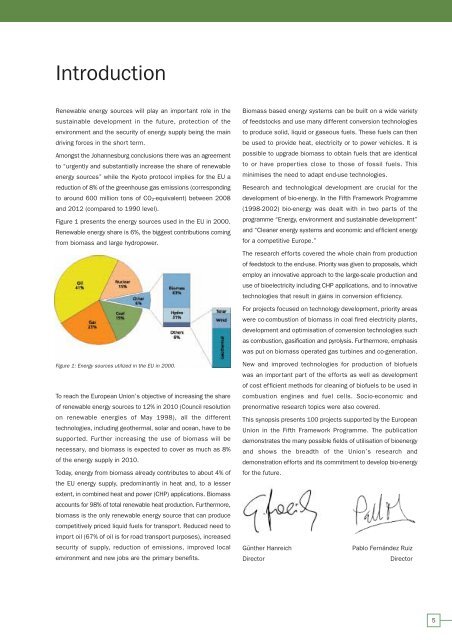European Bio-Energy Projects
European Bio-Energy Projects
European Bio-Energy Projects
Create successful ePaper yourself
Turn your PDF publications into a flip-book with our unique Google optimized e-Paper software.
Introduction<br />
Renewable energy sources will play an important role in the<br />
sustainable development in the future, protection of the<br />
environment and the security of energy supply being the main<br />
driving forces in the short term.<br />
Amongst the Johannesburg conclusions there was an agreement<br />
to “urgently and substantially increase the share of renewable<br />
energy sources” while the Kyoto protocol implies for the EU a<br />
reduction of 8% of the greenhouse gas emissions (corresponding<br />
to around 600 million tons of CO2-equivalent) between 2008<br />
and 2012 (compared to 1990 level).<br />
Figure 1 presents the energy sources used in the EU in 2000.<br />
Renewable energy share is 6%, the biggest contributions coming<br />
from biomass and large hydropower.<br />
Figure 1: <strong>Energy</strong> sources utilized in the EU in 2000.<br />
To reach the <strong>European</strong> Union’s objective of increasing the share<br />
of renewable energy sources to 12% in 2010 (Council resolution<br />
on renewable energies of May 1998), all the different<br />
technologies, including geothermal, solar and ocean, have to be<br />
supported. Further increasing the use of biomass will be<br />
necessary, and biomass is expected to cover as much as 8%<br />
of the energy supply in 2010.<br />
Today, energy from biomass already contributes to about 4% of<br />
the EU energy supply, predominantly in heat and, to a lesser<br />
extent, in combined heat and power (CHP) applications. <strong>Bio</strong>mass<br />
accounts for 98% of total renewable heat production. Furthermore,<br />
biomass is the only renewable energy source that can produce<br />
competitively priced liquid fuels for transport. Reduced need to<br />
import oil (67% of oil is for road transport purposes), increased<br />
security of supply, reduction of emissions, improved local<br />
environment and new jobs are the primary benefits.<br />
<strong>Bio</strong>mass based energy systems can be built on a wide variety<br />
of feedstocks and use many different conversion technologies<br />
to produce solid, liquid or gaseous fuels. These fuels can then<br />
be used to provide heat, electricity or to power vehicles. It is<br />
possible to upgrade biomass to obtain fuels that are identical<br />
to or have properties close to those of fossil fuels. This<br />
minimises the need to adapt end-use technologies.<br />
Research and technological development are crucial for the<br />
development of bio-energy. In the Fifth Framework Programme<br />
(1998-2002) bio-energy was dealt with in two parts of the<br />
programme “<strong>Energy</strong>, environment and sustainable development”<br />
and “Cleaner energy systems and economic and efficient energy<br />
for a competitive Europe.”<br />
The research efforts covered the whole chain from production<br />
of feedstock to the end-use. Priority was given to proposals, which<br />
employ an innovative approach to the large-scale production and<br />
use of bioelectricity including CHP applications, and to innovative<br />
technologies that result in gains in conversion efficiency.<br />
For projects focused on technology development, priority areas<br />
were co-combustion of biomass in coal fired electricity plants,<br />
development and optimisation of conversion technologies such<br />
as combustion, gasification and pyrolysis. Furthermore, emphasis<br />
was put on biomass operated gas turbines and co-generation.<br />
New and improved technologies for production of biofuels<br />
was an important part of the efforts as well as development<br />
of cost efficient methods for cleaning of biofuels to be used in<br />
combustion engines and fuel cells. Socio-economic and<br />
prenormative research topics were also covered.<br />
This synopsis presents 100 projects supported by the <strong>European</strong><br />
Union in the Fifth Framework Programme. The publication<br />
demonstrates the many possible fields of utilisation of bioenergy<br />
and shows the breadth of the Union’s research and<br />
demonstration efforts and its commitment to develop bio-energy<br />
for the future.<br />
Günther Hanreich Pablo Fernández Ruiz<br />
Director Director<br />
5

















